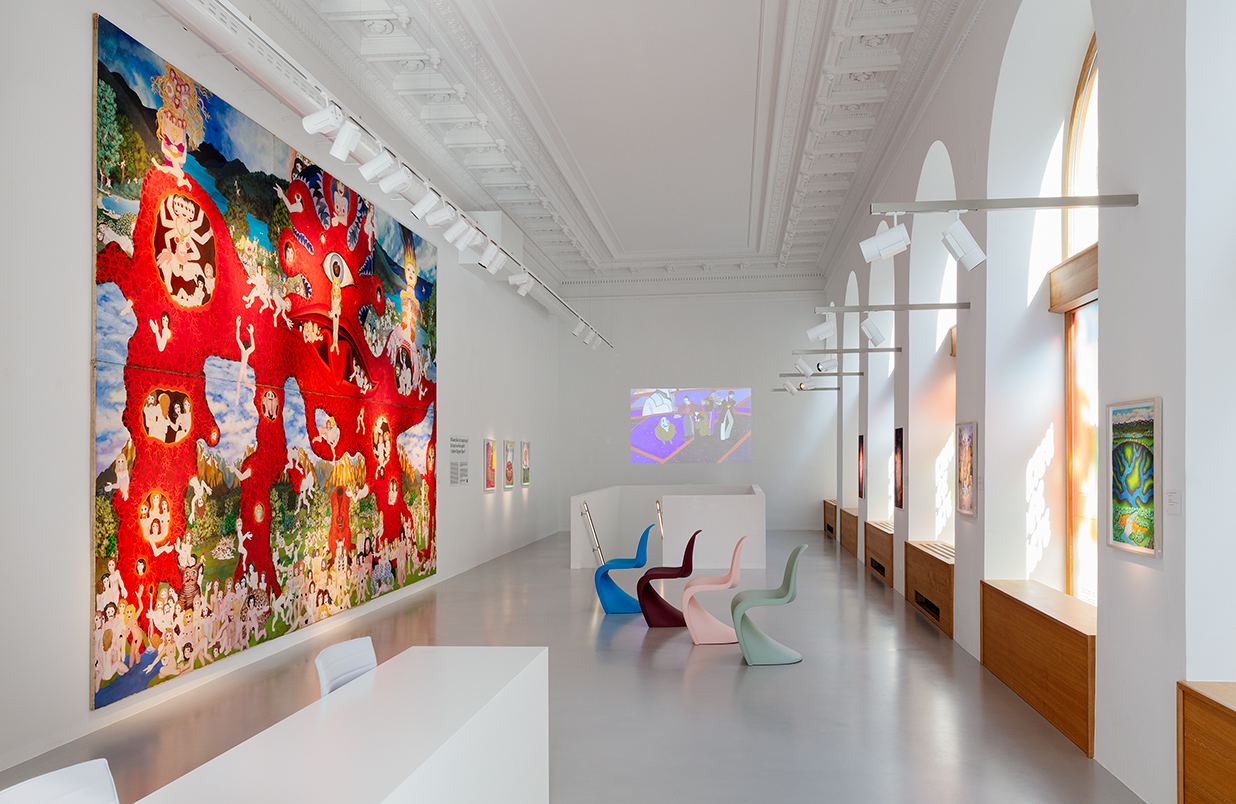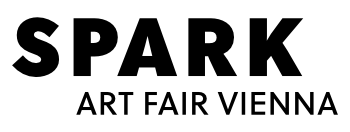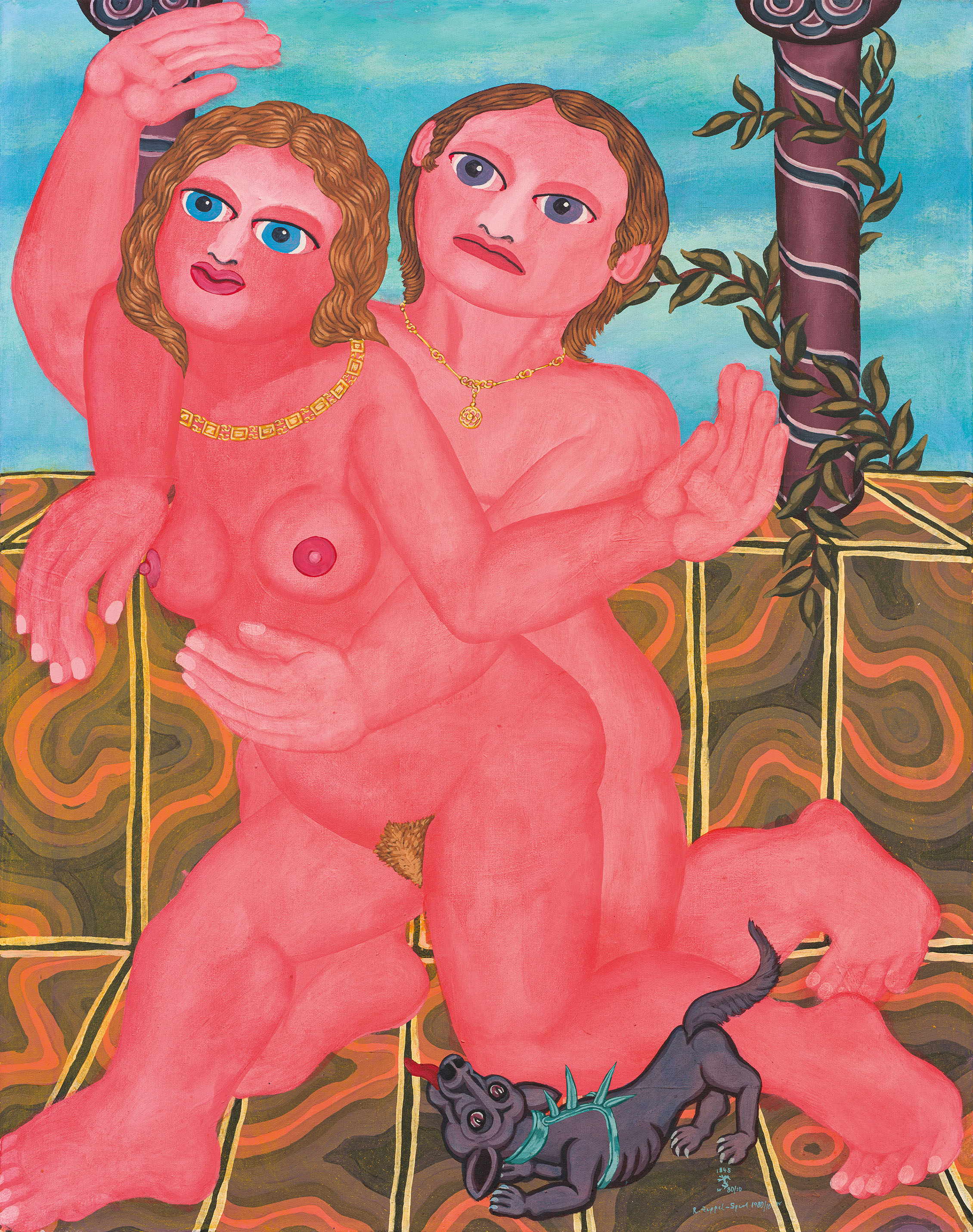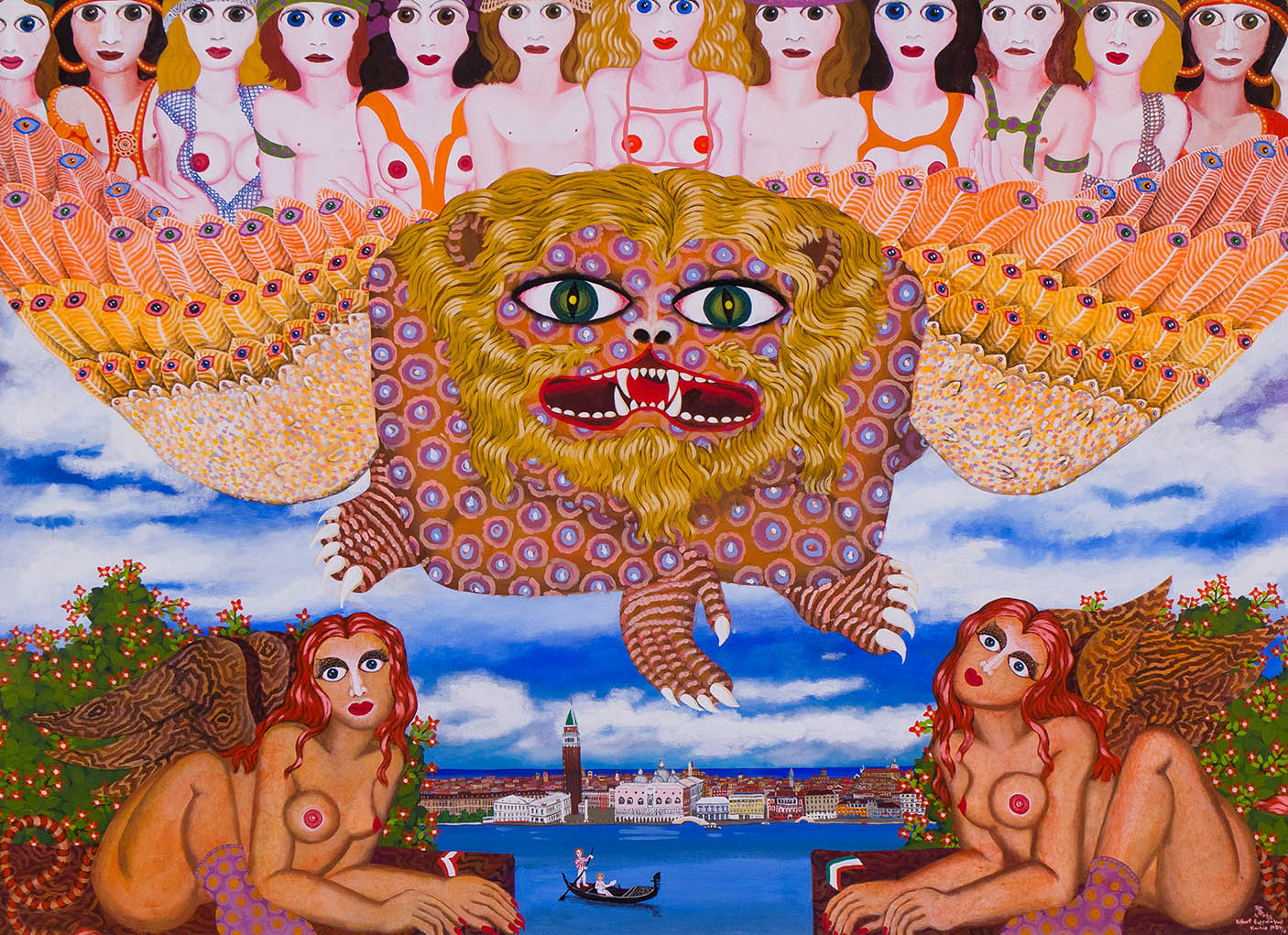Giese & Schweiger
Untitled (Lovers)
1980
Acryl on Canvas
91 x 70 cm
© Giese & Schweiger, Wien
"Venzia (Arrived in Venice)"
1974
Acryl on Canva
144 x 200 cm
© Giese & Schwieger, Wien
Robert Zeppel-Sperl
„We make our own stuff …“
Hippie vibes, flower power, Yellow Submarine, rebellion against social structures and gender roles – in the late 1960s, Robert Zeppel-Sperl mixed a young, avant-garde attitude to life with influences from pop art and old masters to create a memorable, thoroughly serious amalgam of images. As a founding member of the epoch-making group „Wirklichkeiten“, he was one of the artists who emancipated themselves from fantastic realism and Art Informel in 1968, together with Martha Jungwirth, Kurt Kocherscheidt, Peter Pongratz and others, and paved the way for postmodern painting.
With strikingly bright colors, he also painted against the dark gray, stuffy, narrow Vienna of the time. In formats of all sizes, from small to gigantic, he created Byzantine-splendid and Baroque-lush pictorial worlds populated by people, monsters and animals with a penetrating gaze. Oversized eyes are not only motivic pivot points, but also serve as an interface between inside and outside. As permeable membranes, they allow messages of an intense inner (experience) life to penetrate to the outside. At the same time, they provide access to a pictorial dimension that is characterized by a modern, egocentric attitude to life. An aspect that is more topical than ever.
Biography
Robert Zeppel-Sperl, a member of the Vienna Secession and co-founder of the artist group „Wirklichkeiten“ (Realities), decided in 1961 to devote himself to painting. From 1962 to 1968, he attended the Vienna Academy of Fine Arts and studied under Maximilian Melcher and Max Weiler. In May 1968, he celebrated his first great success at the legendary Secession exhibition „Wirklichkeiten“. On the initiative of Otto Breicha, Zeppel-Sperl, Wolfgang Herzig, Martha Jungwirth, Kurt Kocherscheidt, Peter Pongratz and Franz Ringel had come together and – stylistically quite heterogeneous – sent a strong signal for an artistic upheaval in Austria. Before that, the local art scene had been dominated by Fantastic Realism and the “Gruppe St. Stephan” ( – Actionism would only premier shortly after the „Wirklichkeiten“ with the famous action „Kunst und Revolution“ at the University of Vienna). In contrast to the prevailing abstraction, Zeppel-Sperl turned to a new representationalism and took up impulses from Old Masters (e.g. Hieronymus Bosch) as well as from international contemporary art and comics. In terms of content, his imagery was characterised by the joie de vivre of the 1960s and early 70s, but also by sociocritical themes. In 1969, he moved to Venice, where from 1995 he created several glass sculptures for the glass manufacturer Berengo in Murano. From 1977, he lived partly in the USA before setting up his studio in Bali from 1991. After that, he commuted regularly between Bali, Vienna and Venice.
Literature: O. Breicha, „Robert Zeppel-Sperl. Eine Monographie“, Salzburg 1993; „Robert Zeppel-Sperl, Bilder aus der Slg. Großhaus u. Glasskulpturen aus der Slg. Berengo, Palazzo delle Prigioni Nouve, Venedig, Hrsg. v. Hamburger Förderkreis Kunstausstellungsprojekte e. V., 2001
Giese & Schweiger
Ambition, competence and a good gut feeling have made the art dealership Giese & Schweiger, founded in 1980, the first address for Austrian painting of the 19th and 20th centuries. Significant positions from art after 1945 through to contemporary art now also create a link to contemporary art. – The quality factor and the potential to become a „masterpiece“ connect across the epochs.
Exhibitions in the spacious gallery premises and participation in art fairs are regular highlights of the program. Elaborate publications, including individual presentations of important Austrian and international artists, accompany these activities.

+4315131843
Alexander Giese
+4315131843
Robert Zeppel-Sperl
„We make our own stuff …“
Hippie vibes, flower power, Yellow Submarine, rebellion against social structures and gender roles – in the late 1960s, Robert Zeppel-Sperl mixed a young, avant-garde attitude to life with influences from pop art and old masters to create a memorable, thoroughly serious amalgam of images. As a founding member of the epoch-making group „Wirklichkeiten“, he was one of the artists who emancipated themselves from fantastic realism and Art Informel in 1968, together with Martha Jungwirth, Kurt Kocherscheidt, Peter Pongratz and others, and paved the way for postmodern painting.
With strikingly bright colors, he also painted against the dark gray, stuffy, narrow Vienna of the time. In formats of all sizes, from small to gigantic, he created Byzantine-splendid and Baroque-lush pictorial worlds populated by people, monsters and animals with a penetrating gaze. Oversized eyes are not only motivic pivot points, but also serve as an interface between inside and outside. As permeable membranes, they allow messages of an intense inner (experience) life to penetrate to the outside. At the same time, they provide access to a pictorial dimension that is characterized by a modern, egocentric attitude to life. An aspect that is more topical than ever.
Biography
Robert Zeppel-Sperl, a member of the Vienna Secession and co-founder of the artist group „Wirklichkeiten“ (Realities), decided in 1961 to devote himself to painting. From 1962 to 1968, he attended the Vienna Academy of Fine Arts and studied under Maximilian Melcher and Max Weiler. In May 1968, he celebrated his first great success at the legendary Secession exhibition „Wirklichkeiten“. On the initiative of Otto Breicha, Zeppel-Sperl, Wolfgang Herzig, Martha Jungwirth, Kurt Kocherscheidt, Peter Pongratz and Franz Ringel had come together and – stylistically quite heterogeneous – sent a strong signal for an artistic upheaval in Austria. Before that, the local art scene had been dominated by Fantastic Realism and the “Gruppe St. Stephan” ( – Actionism would only premier shortly after the „Wirklichkeiten“ with the famous action „Kunst und Revolution“ at the University of Vienna). In contrast to the prevailing abstraction, Zeppel-Sperl turned to a new representationalism and took up impulses from Old Masters (e.g. Hieronymus Bosch) as well as from international contemporary art and comics. In terms of content, his imagery was characterised by the joie de vivre of the 1960s and early 70s, but also by sociocritical themes. In 1969, he moved to Venice, where from 1995 he created several glass sculptures for the glass manufacturer Berengo in Murano. From 1977, he lived partly in the USA before setting up his studio in Bali from 1991. After that, he commuted regularly between Bali, Vienna and Venice.
Literature: O. Breicha, „Robert Zeppel-Sperl. Eine Monographie“, Salzburg 1993; „Robert Zeppel-Sperl, Bilder aus der Slg. Großhaus u. Glasskulpturen aus der Slg. Berengo, Palazzo delle Prigioni Nouve, Venedig, Hrsg. v. Hamburger Förderkreis Kunstausstellungsprojekte e. V., 2001
Giese & Schweiger
Ambition, competence and a good gut feeling have made the art dealership Giese & Schweiger, founded in 1980, the first address for Austrian painting of the 19th and 20th centuries. Significant positions from art after 1945 through to contemporary art now also create a link to contemporary art. – The quality factor and the potential to become a „masterpiece“ connect across the epochs.
Exhibitions in the spacious gallery premises and participation in art fairs are regular highlights of the program. Elaborate publications, including individual presentations of important Austrian and international artists, accompany these activities.


